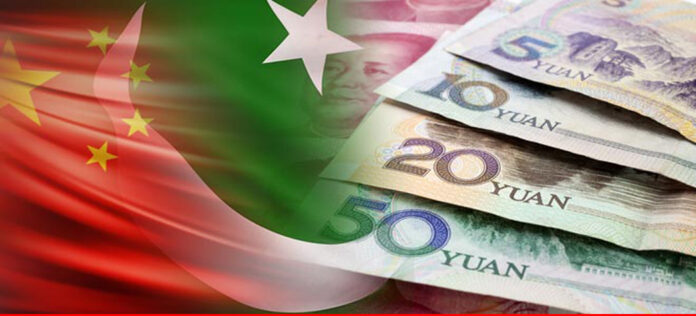During the recent visit of Pakistan’s prime minister to China, the two nations inked a memorandum of cooperation on the clearance of the Chinese currency, the yuan, in Pakistan. A clearing system, also described as a clearing house, serves as the intermediary between two parties and is also the agency through which financial instruments such as stocks, bonds, and currencies are often exchanged. However, one lingering question remains: can such an unprecedented step address Pakistan’s economic woes?
Pakistan is in the grip of a crippling balance-of-payments crisis. At the time, the trade structure is unfavorable since imports vastly outnumber exports. According to Pakistani analysts and businessmen, the move is intended to minimize reliance on the US greenback. The move comes at a time when Islamabad’s currency reserves are rapidly depleting and the rupee is under pressure from mounting imports.
Arguably, fluctuations in currency distort local business confidence and exacerbate the balance of payment crisis, particularly via trade deficits. The rupee has already depreciated substantially against the dollar, and it will continue to lose value as a result of the probable negative spillover impact of an increase in interest rates and tighter monetary policy in the USA. On the other hand, the yuan’s benefit as a pricing tool stems from its stability, expanding significance in international settlements and payments, and support from China’s economic strength. For instance, since the worldwide cobid-19 outbreak, the Chinese Yuan has depreciated less than other major currencies versus the US dollar. The Japanese yen has dropped 48 percent from its high since the outbreak, while the euro has been down 22 percent, following a 27 percent drop in the British pound, and the Korean won has dropped 33 percent. The Yuan fell by 16 percent.
However, opting for the Yuan clearing deal is not the panacea for all economic woes. The prime issue is the alarming trade deficit with China. In FY22, the overall trade volume between the two nations reached $20 billion, with Pakistan exporting less than $3 billion and importing $17.2 billion from China. Chinese exports to Pakistan have surpassed $150 billion in the previous ten years. Almost 40 percent of Pakistan’s overall trade deficit results from trade with China. In the short term, the currency clearing agreement will assist Pakistan by reducing pressure on the rupee against the dollar by approximately 20 percent. However, unless Pakistan’s trade balance with China improves, the country may face another balance of payment crisis, even if payments are made in Chinese currency.
A slight increase in interest rates by the Federal Reserve raises the value of the US dollar, rendering Pakistani items uncompetitive on the global market. Because the yuan is less sensitive to worldwide volatility, Pakistani goods may be more competitive for exports to China and find a larger market share in the Chinese as well as other Asian markets. This is because the potential for trading in yuan is expanding as its reserves in global central banks grow. Thus, Pakistan must take advantage of a once-in-a-lifetime trading opportunity under the China-Pakistan free trade agreement (Phased-II) spanning 2019-2024, in which substantial tariff concessions have been offered to Pakistani exports.
Pakistan must strive for corrective measures to balance its unbalanced trade structure, as well as fundamental policy adjustments. First, Pakistan must enhance its productive capacity and value addition in goods. Agriculture productivity is relatively poor in comparison to regional competitors; for instance, cotton yield in Pakistan is 1.7 tonnes per hectare, compared to 9 tonnes per hectare in China. Human capital investment is critical for increasing labour productivity. Pakistan must aim to strengthen its knowledge capital, which will be a significant driver of future productivity, diversity, greater innovation, and hence higher growth.
Second, it is imperative to have person-to-person or business-to-business contact, which connects our small and medium-sized businesses to the global value chain. This will modernize and upgrade our industrial structure while also generating much-needed revenue. Vietnam, for example, is linked with Samsung in the manufacture of mobile components and earns a sizable $72 billion annually. In Pakistan, the bulk of manufacturing industries is inward looking, that is, meeting the demand of domestic users. Industries such as fan and electronics have enormous potential and must integrate with the global value chain to acquire skills and enhance manufacturing capacity.
Third, the timely completion of Mainline-1 (ML-1) is essential since it will offer tremendous economic benefits. ML-1 is a vital project of the China-Pakistan Economic Corridor (CPEC) and comprises a major infrastructure rehabilitation of the 1680 km of railway rails from Karachi to Peshawar. The project will assist in the relocation of industries to economic zones, as well as the transfer of freight from roadways to trains. It will not only lower transportation costs but also increase efficiency, reducing travel time between the two cities by half.
Finally, at the present, the majority of trade between Pakistan and China is conducted in US dollars. The Chinese yuan is more stable than the US dollar since it is not a worldwide currency. Against this setting, yuan-based payment systems have the potential to significantly boost Pakistan’s export competitiveness.
A slight increase in interest rates by the Federal Reserve raises the value of the US dollar, rendering Pakistani items uncompetitive on the global market. Because the yuan is less sensitive to worldwide volatility, Pakistani goods may be more competitive for exports to China and find a larger market share in the Chinese as well as other Asian markets. This is because the potential for trading in yuan is expanding as its reserves in global central banks grow. Thus, Pakistan must take advantage of a once-in-a-lifetime trading opportunity under the China-Pakistan free trade agreement (Phased-II) spanning 2019-2024, in which substantial tariff concessions have been offered to Pakistani exports.























